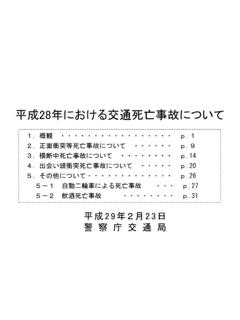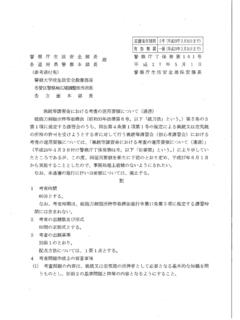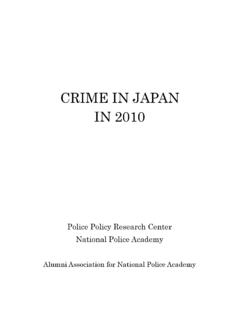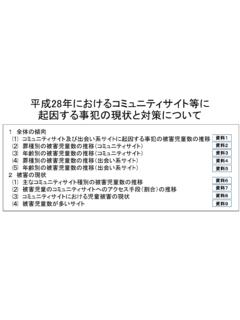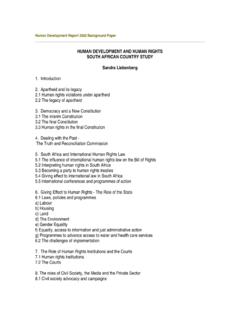Transcription of P OLICE OF JAPAN - 警察庁
1 POLICE OF JAPAN CONTENTS .. ORGANIZATIONAL STRUCTURE & RESOURCES 1. Responsibilities 1 2. History 2 3. Organizational Structure 2 4. Human Resources 8 5. Budget 11 6. Equipment 12 COMMUNITY SAFETY 1. Community Policing 13 2. Crime Prevention 15 3. Countermeasures against Personal Safety-Threatening Cases 16 4. Sound Growth of Amusement Businesses 16 5. Preventing Deterioration of Public Morals 16 6. Countermeasures against Economic Crimes 17 7. Prevention of Juvenile Delinquency and Sound Development of Youth 18 8. Countermeasures against Cybercrime 21 SUPPORT FOR CRIME VICTIMS 1. Police Support for Victims 24 2.
2 Cooperation with Private Organizations for Victim Support 25 CRIMINAL INVESTIGATION 1. Overview 26 2. Fight against Organized Crimes 28 3. Firearms Control 30 4. Drug Control 31 5. Prevention of Money Laundering and Terrorist Financing 34 6. Fight against Crime Infrastructures 35 .. TRAFFIC POLICE 1. Overview 36 2. Enforcement 36 3. ITS Developed by the Japanese Police 38 4. Driver s License 39 5. Promotion of Traffic Safety Education and Campaigns 39 SECURITY POLICE 1. Overview 40 2. Various Activities 43 3. Crisis Management System after the Great East JAPAN Earthquake 45 CYBER SECURITY Strategy and Structure to Counter Cyber Threats 46 POLICE SCIENCE & INFO-COMMUNICATIONS 1.
3 Police Info-Communications 48 2. Criminal Identification 51 3. National Research Institute of Police Science 52 INTERNATIONAL COOPERATION 1. Technical Assistance 55 2. International Cooperation in Fighting Transnational Crimes 57 Appendices 1. Number of Juveniles Arrested for Penal Code Offenses (2019) 59 2. Number of Penal Code Offenses Known and Cleared (2015-2019) 60 3. Numbers of Traffic Violations 61 1 1. Responsibilities Police responsibilities under the Police Act include "protecting the lives, bodies, and property of individuals; preventing, suppressing, and investigating crimes; apprehending suspects; traffic enforcement; and, maintaining public safety and order." The Code of Criminal Procedure states that "when a judicial police official deems that an offense has been committed, s/he shall investigate the offender and evidence thereof.
4 " Accordingly, the police are empowered to investigate not only penal code offenses but also all illegal acts punishable under JAPAN 's judicial system. Most cases are investigated by the police and referred to the public prosecutor s office for prosecution. While public prosecutors are also empowered to conduct investigations, their investigations are generally supplementary. The primary duty of the public prosecutor is to determine the case dispositions and prosecute the suspects. Several other authorities such as the JAPAN Coast Guard and the Narcotics Control Department also possess investigative powers, which are authorized by the law. Their investigations are generally limited in scope and number. In addition to criminal investigations, the police perform a wide range of administrative activities to maintain public safety and order applying various acts such as the Road Traffic Act and the Anti-Boryokudan Act.
5 The police also maintain close contact with local communities to: Prevent crimes; Handle lost and found property; Give guidance to juveniles; Help people in times of disasters; Provide care for lost children and runaways; and, Offer counseling to help citizens solve their problems. ORGANIZATIONAL STRUCTURE & RESOURCES 2 2. History In 1872, the Japanese government sent the first Superintendent General Toshiyoshi KAWAJI to Europe to study the police system. He returned the following year, then established the Tokyo Metropolitan Police Department in the Ministry of Interior in 1874. This was the first modern police organization in JAPAN . Police power, at that time, was held by the national government. In the process of democratization of JAPAN after World War II, the Public Safety Commission system was established under the former Police Act enforced in 1948 .
6 This created a structure consisting of national and municipal police with the aim of ensuring democratic management and decentralization of police power. The former Police Act had an epochal significance in democratizing the police. However, it had institutional shortcomings such as the existence of a multitude of municipal police forces in parallel with the National Rural Police. This caused several problems such as inefficiency of police force operations and low cost-effectiveness due to geographical segmentation of the police units and unclear distinction of responsibilities between the municipal police forces and the national government in terms of maintaining public peace and order. Hence, the former Police Act was amended in its entirety into the present act in 1954 by retaining its merits and improving the institutional shortcomings. Consequently, the National Police Agency was established and the present police system was formed.
7 3. Organizational Structure The Police Act empowers the national government to establish a central police organization to control and supervise prefectural police forces on matters of national concern. The Act also gives each prefecture the authority to carry out police duties to "protect the lives, bodies, and property of individuals" and "maintain public safety and order" within its jurisdiction. At both the national and prefectural levels, Public Safety Commissions have administrative supervision powers over the police. A. National Police Structure The National Public Safety Commission (NPSC) and the National Police Agency (NPA) constitute JAPAN 's national police organization. (1) National Public Safety Commission After World War II, the Public Safety Commission system was established through the police reform. The main objective of establishing this system was to ensure democratic administration and political neutrality of the police under the administrative supervision by the Commission which consists of members representing the good sense of the public.
8 3 The NPSC supervises the NPA. The Prime Minister is not empowered to exercise direct command or control over the Commission. This ensures the political neutrality of the Commission draws up basic policies and regulations, coordinates police administration on matters of national concern and sets general standards for training, communications, criminal identification, criminal statistics, and equipment. The Commission appoints the Commissioner General of the NPA and chiefs of prefectural police organizations. The Commission indirectly supervises prefectural police organizations through the NPA. The Commission is composed of a chairperson and five members. To make it clear that the responsibility for public safety lies with the cabinet, a state minister is assigned as the chair, who presides over the Commission meetings. Members are appointed by the Prime Minister with the consent of both houses of the Diet and serve a five-year term.
9 Individuals who served as professional public servants in the police or prosecution in the preceding five years may not be appointed. To ensure political neutrality, no more than two members may be appointed from the same political party. To fulfill its duty, the Commission holds a regular weekly meeting and additional meetings where necessary. System of Public Safety Commissions Prime Minister Prefectural Governor Authority Authority National Public Safety Commission Chairperson (Minister of State) 5 Members Administrative Supervision National Police Agency Commissioner General Prefectural Police Organization Prefectural Public Safety Commission 3 or 5 Members Administrative Supervision Prefectural Police Headquarters Supervision and control within the agency s defined duties Note 1 The Commissioner General is appointed by the NPSC with the approval of the Prime Minister Note 2 The Superintendent-General of the MPD is appointed by the NPSC with the consent of the Tokyo Public Safety Commission and approval of the Prime Minister.
10 Chiefs of Prefectural Police are appointed by the NPSC with the consent of the respective PPSCs. 4 (2) National Police Agency (a) Organizational Structure and Authority The Commissioner General, leading the NPA, is appointed by the NPSC with the approval of the Prime Minister. The Commissioner General, under the supervision of the Commission, oversees the agency's operations, appoints agency employees, and manages prefectural police organizations. The NPA, as a national agency, formulates police systems and also conducts police operations regarding cases involving national public safety, undertakes administration of matters which form the foundation of police activities such as police education and training, police communications, and criminal identification as well as coordination of police administration.



